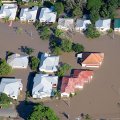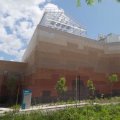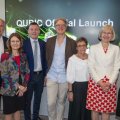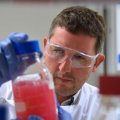The UQ Solar Array underpins a number of cutting-edge research projects, in diverse fields including physics, engineering, economics and sustainability.
Construction of the array was completed this month and it was officially launched today by Energy Minister Stephen Robertson.
Professor Paul Meredith, who is overseeing a number of research projects on the 1.22 megawatt UQ Solar Array, said the system gave UQ research opportunities unparalleled in Australia and positioned Queensland at the global forefront of renewable energy research.
“A major objective of our array research program is to provide a clearer understanding of how to integrate megawatt-scale renewable energy sources into an urban grid,” said Professor Meredith, of UQ’s School of Mathematics and Physics and Global Change Institute.
“Currently Australia's power grid is designed for a very small number of massive power generating plants – mostly coal, gas or hydro.
“In future, it will need to accommodate many, many more, smaller input sources in diverse locations, from renewable resources such as solar, geothermal and wind.
“Mid-size, commercial-scale renewable power generating systems like UQ's will become increasingly common in urban and remote areas.
“Addressing the engineering issues around how these systems can feed into and integrate with the grid is essential so that people can really understand and calculate their value as we transition to lower-emission forms of energy.”
Electricity distributor and retailer Energex has joined UQ as a partner in this research project, and contributed for state-of-the-art equipment to allow high-quality monitoring and analysis of the power feed from the St Lucia solar array.
Another key UQ Solar research project involves addressing one of the most common criticisms of solar power: that it cannot replace 24/7 baseload grid power because it can only be generated when the sun is shining.
Through a partnership with ASX-listed Brisbane company RedFlow, a world leader in electricity storage technology, a 200kW battery bank will be connected to a 339kW section of UQ's solar array and allow significant research into techniques for capturing solar power during the day and feeding it into the grid at night and other times of peak demand.
“The RedFlow system uses next-generation zinc bromine batteries,” Professor Meredith said.
“These are more efficient than the lead-acid batteries that have been more common to date, and being filled with water rather than acid, they are much, much more environmentally friendly.”
Solar power generation has grown exponentially in Australia in the past decade, and particularly in the past two years, he said.
Developing effective, safe and cost-effective techniques for storing that power for use when needed would be a vital boost for the continued growth of the solar industry, and for securing its place as a reliable baseload power supplier.
The UQ Solar project at St Lucia had a total cost of $7.75 million, including the array, construction of a visitor resource centre, the data management web interface and ancillary research programs.
The actual cost of the photovoltaic design and installation was $4.825 million, equating to $3.95/W.
Media:
Craig Froome, UQ Global Change Institute, ph 07 3365 3689/0410 559 135
Fiona Cameron, UQ Communications, ph 07 3346 7086 / 0407 113342
Phil Hutchings, CEO, RedFlow, ph 07 3376 0008 / 0402 120 531
Terry McConnell, Energex, ph 07 3664 4329 / 0419 718 392
UQ solar and energy researchers who will be working on the UQ Solar Array include:
Professor Paul Meredith meredith@physics.uq.edu.au ph +61 7 3365 7050
Professor Meredith is a materials physicist at The University of Queensland, where his focus is on investigating new sustainable high-tech materials for applications including more efficient production of solar energy.
He is co-director of UQ’s Centre for Organic Photonics and Electronics and a Vice Chancellors Senior Research Fellow. He co-founder and is Director of Research of the solar coatings company Brisbane Materials Technology.
Professor Meredith's research focuses on next-generation, sustainable high-tech materials and specifically materials for organic optoelectronics in applications such as plastic electronics, sensing, bio-electronics and organic photovoltiacs.
He has published more than 180 scientific articles, papers and patents on his research and also has a broader interest in solar energy development and deployment.
He chairs the UQ Renewable Energy Technology Advisory Committee and leads several large solar infrastructure projects, including the deployment of Australia’s largest flat-panel solar photovoltaic system, the 1.22MW array at UQ’s St Lucia campus.
He is a passionate advocate of renewable energy and serves on the Queensland Premier’s Climate Change Council and the Smart State Council working group on Queensland’s Energy Future.
Professor Tapan Saha saha@itee.uq.edu.au ph +61 7 336 53962
Professor Saha is Professor of Electrical Engineering and leader of the Power & Energy Systems research group in the School of Information Technology and Electrical Engineering at The University of Queensland.
Professor Saha’s research interests include condition monitoring of electrical equipment, power system stability and control and integration of renewable energy to the national grid.
He is a member of the UQ Renewable Energy Technology Advisory Committee and has been involved with the Australia’s largest flat-panel solar photovoltaic system, the 1.22MW array at UQ’s St Lucia campus.
He has been actively involved with the Australian panels of CIGRE (the International Council on Large Electric Systems), and is a senior member of the IEEE. He is a CPEng and Fellow of Engineers Australia. He is the Chair of IEEE Power & Energy Society Chapter of Queensland Section and Vice Chair of Queensland Electrical Branch of Engineers Australia.
Professor John Foster J.foster@economics.uq.edu.au ph +61 7 3371 2096 mobile 0418 119 320
Professor Foster has been a Professor of Economics at The University of Queensland since 1991, was Head of the School of Economics from 1999 to 2008 and is now Leader of the Energy Economics and Management Group (EEMG).
His research interests are in innovation strategies and policies to promote renewable energy; modelling the impacts of carbon mitigation policies on the generation, transmission and distribution of electricity and on the wider economy; developing statistical / econometric modelling methodologies; integrating the energy sector into an evolutionary macroeconomic model of economic growth; and complex economic systems theory.
Mr Craig Froome c.froome@uq.edu.au ph +61 7 3365 3689 mobile 0410 559 135
Mr Froome is Renewable Energy Coordinator at UQ’s Global Change Institute.
He has extensive consulting experience and has undertaken a number of projects looking at renewable energy scenarios including the preparation of a discussion papers for both Government and industry.
He is a member of The University of Queensland’s Renewable Energy Technical Advisory Committee, which will look at renewable energy projects that may be implemented on the University’s campuses for the purposes of energy generation, and also research and teaching opportunities.
Mr Froome was instrumental in the deployment of the 1.2 MW solar array at the St Lucia Campus.
Mr Froome is a member of UQ’s School of Economics Energy Economics and Management Research Group which is focusing on recent and ongoing technological change and diffusion that is making key technologies, such as battery storage, solar PV and thermal more affordable.
In conjunction with the EEMRG he is also working on the I-Grid linkage program with the CSIRO Distributed Energy Flagship; the goal of that project is to rigorously model and quantify the benefits of distributed energy systems while, at the same time, taking into account the costs of deploying and integrating them into the Australian electricity system.
Dr Liam Wagner L.wagner@uq.edu.au ph +61 7 3365 6601 mobile 0403 333 509
Dr Wagner is a research fellow in the UQ School of Economics, undertaking research on energy markets and the transition to a low-carbon economy.
He has worked as an energy industry trader and analyst, providing advice on risk. He worked in electricity trading for a large Australia electricity generator that produced power through an open cycle gas turbine power station.
While working in the energy industry, Dr Wagner performed analysis on the impending carbon economy and its effects on electricity generators.
He has extensive experience in the economics of renewable energy and climate change adaptation and carbon management.
Dr Wagner has developed several modelling platforms to examine the effects of carbon pricing, emissions trading systems and renewable energy targets on electricity markets.
Dr Nadarajah Mithulananthan mithulan@itee.uq.edu.au +61 7 336 54194
Dr Mithulananthan is a senior lecturer in UQ’s School of Information Technology and Electrical Engineering.
His research interests focus on analytical studies on electric power grids, power system interconnections, integration of renewable energy into electric power grids and future power grids.
Prior to March, 2009, we was attached to the energy field of study at the Asian Institute of Technology as an Associate Professor.
At AIT he supervised many masters and doctoral students and was involved in numerous projects, with a total budget of $US2million, as a principal / co-principal investigator.
Based on his research, he has published more than 60 articles.
Previously he has worked as Planning Engineer at Generation Planning Division at Ceylon Electricity Board and Project Leader at the Centre of Excellence in Electric Power Technology at Chulalongkorn University, Thailand.
The UQ Global Change Institute
The Global Change Institute at The University of Queensland, Australia, is a new source of game-changing research, ideas and advice for addressing the challenges of global change.
The Global Change Institute advances discovery, creates solutions and advocates changes to policies that respond to challenges presented by climate change, technological innovation and population change.
.jpg)












